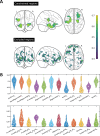The Effect of Overcoming the Digital Divide on Middle Frontal Gyrus Atrophy in Aging Adults: Large-Scale Retrospective Magnetic Resonance Imaging Cohort Study
- PMID: 40694409
- PMCID: PMC12306509
- DOI: 10.2196/73360
The Effect of Overcoming the Digital Divide on Middle Frontal Gyrus Atrophy in Aging Adults: Large-Scale Retrospective Magnetic Resonance Imaging Cohort Study
Abstract
Background: The rapid integration of information technology into daily life has exacerbated the digital divide (DD), particularly among older adults, who often face barriers to technology adoption. Although prior research has linked technology use to cognitive benefits, the long-term neurostructural and cognitive consequences of the DD remain poorly understood.
Objective: The aim of this study is to use large-scale neuroimaging data to examine how the DD affects long-term brain structure and cognitive aging in older adults. It specifically investigates (1) structural and cognitive differences between older adults with and without DD engagement, (2) predictive relationships between group-distinctive brain regions and cognitive outcomes, and (3) longitudinal impacts of DD exposure on accelerated aging trajectories of neural substrates and cognitive functions.
Methods: The study included 1280 community-dwelling older adults (aged 65-90 y) who completed comprehensive cognitive assessments and structural magnetic resonance imaging scans at baseline. Longitudinal data were available for 689 participants (mean follow-up 3.2 y). Participants were classified into the DD (n=640) and overcoming DD (n=640) groups using rigorous propensity score matching to control for age, education, gender, and baseline health conditions. A computational framework using the searchlight technique and cross-validation classification model investigated group differences in structural features and cognitive representation. The aging rate of each voxel's structural feature was calculated to explore the long-term influence of the DD.
Results: The DD group showed significant deficits in executive function (t=4.75; P<.001; Cohen d=0.38) and processing speed (t=4.62; P<.001; Cohen d=0.37) compared to the overcoming DD group. Reduced gray matter volume in the DD group spanned the fusiform gyrus, hippocampus, parahippocampal gyrus, and superior temporal sulcus (false discovery rate-corrected P<.05). The computational framework identified the key structural substrates related to executive function and processing speed, excluding the ventro-orbitofrontal lobe (classification accuracy <0.6). Longitudinal findings highlighted the long-term impact of the DD. The DD group exhibited faster gray matter volume decline in the middle frontal gyrus (t=3.95 for the peak voxel in this cluster, false discovery rate-corrected P<.05), which mediated 17% of episodic memory decline (P=.02).
Conclusions: Older adults who overcome the DD demonstrate preserved gray matter structure and slower cognitive decline, particularly in frontotemporal regions critical for executive function. Our findings underscore that mobile digital interventions should be explored as potential cognitive decline prevention strategies.
Keywords: cognitive aging; digital divide; internet use; neural decline; neuroplasticity; sMRI; structural magnetic resonance imaging.
© Yumeng Li, Xinyue Zhang, Jiaqing Sun, Junying Zhang, Aiqin Zhu, Xin Li, Zhanjun Zhang. Originally published in the Journal of Medical Internet Research (https://www.jmir.org).
Conflict of interest statement
Figures





Similar articles
-
Short-Term Memory Impairment.2024 Jun 8. In: StatPearls [Internet]. Treasure Island (FL): StatPearls Publishing; 2025 Jan–. 2024 Jun 8. In: StatPearls [Internet]. Treasure Island (FL): StatPearls Publishing; 2025 Jan–. PMID: 31424720 Free Books & Documents.
-
Falls prevention interventions for community-dwelling older adults: systematic review and meta-analysis of benefits, harms, and patient values and preferences.Syst Rev. 2024 Nov 26;13(1):289. doi: 10.1186/s13643-024-02681-3. Syst Rev. 2024. PMID: 39593159 Free PMC article.
-
Cognitive and Spontaneous Brain Activity in Nonaddictive Smartphone Users Among Older Adults in China: Cross-Sectional Study.J Med Internet Res. 2025 Jul 24;27:e63485. doi: 10.2196/63485. J Med Internet Res. 2025. PMID: 40705691 Free PMC article.
-
Computer and mobile technology interventions for self-management in chronic obstructive pulmonary disease.Cochrane Database Syst Rev. 2017 May 23;5(5):CD011425. doi: 10.1002/14651858.CD011425.pub2. Cochrane Database Syst Rev. 2017. PMID: 28535331 Free PMC article.
-
Regional cerebral blood flow single photon emission computed tomography for detection of Frontotemporal dementia in people with suspected dementia.Cochrane Database Syst Rev. 2015 Jun 23;2015(6):CD010896. doi: 10.1002/14651858.CD010896.pub2. Cochrane Database Syst Rev. 2015. PMID: 26102272 Free PMC article.
References
-
- van Dijk J, Hacker K. The digital divide as a complex and dynamic phenomenon. The Information Society. 2003 Sep;19(4):315–326. doi: 10.1080/01972240309487. doi. - DOI
-
- van Dijk J. Digital divide research, achievements and shortcomings. Poetics (Amst) 2006 Aug;34(4-5):221–235. doi: 10.1016/j.poetic.2006.05.004. doi. - DOI
-
- Anderson M, Perrin A. Tech adoption climbs among older adults. Pew Research Center. 2017. [11-07-2025]. http://www.pewinternet.org/2017/05/17/tech-adoption-climbs-among-older-a... URL. Accessed.
-
- Horrigan JB. Washington, DC: John B. Horrigan; 2014. [11-07-2025]. Digital readiness: nearly one-third of americans lack the skills to use next-generation “internet of things” applications.https://jbhorrigan.weebly.com/uploads/3/0/8/0/30809311/digital_readiness... URL. Accessed.
MeSH terms
LinkOut - more resources
Full Text Sources
Medical

